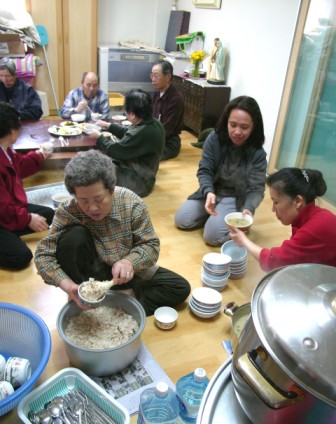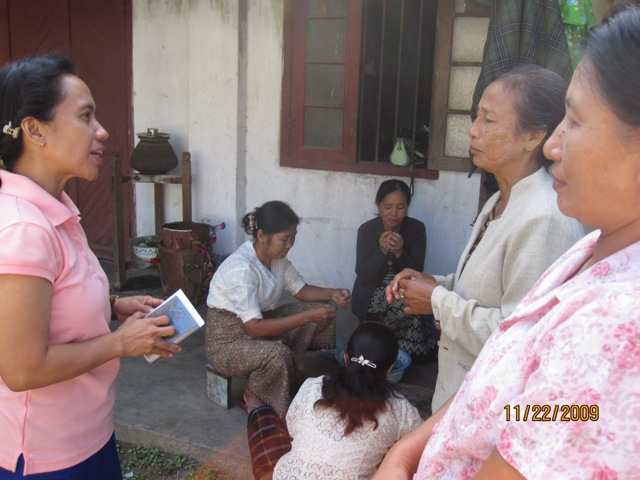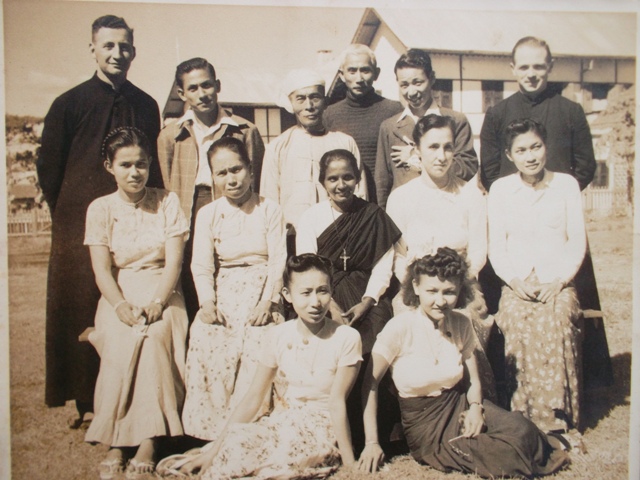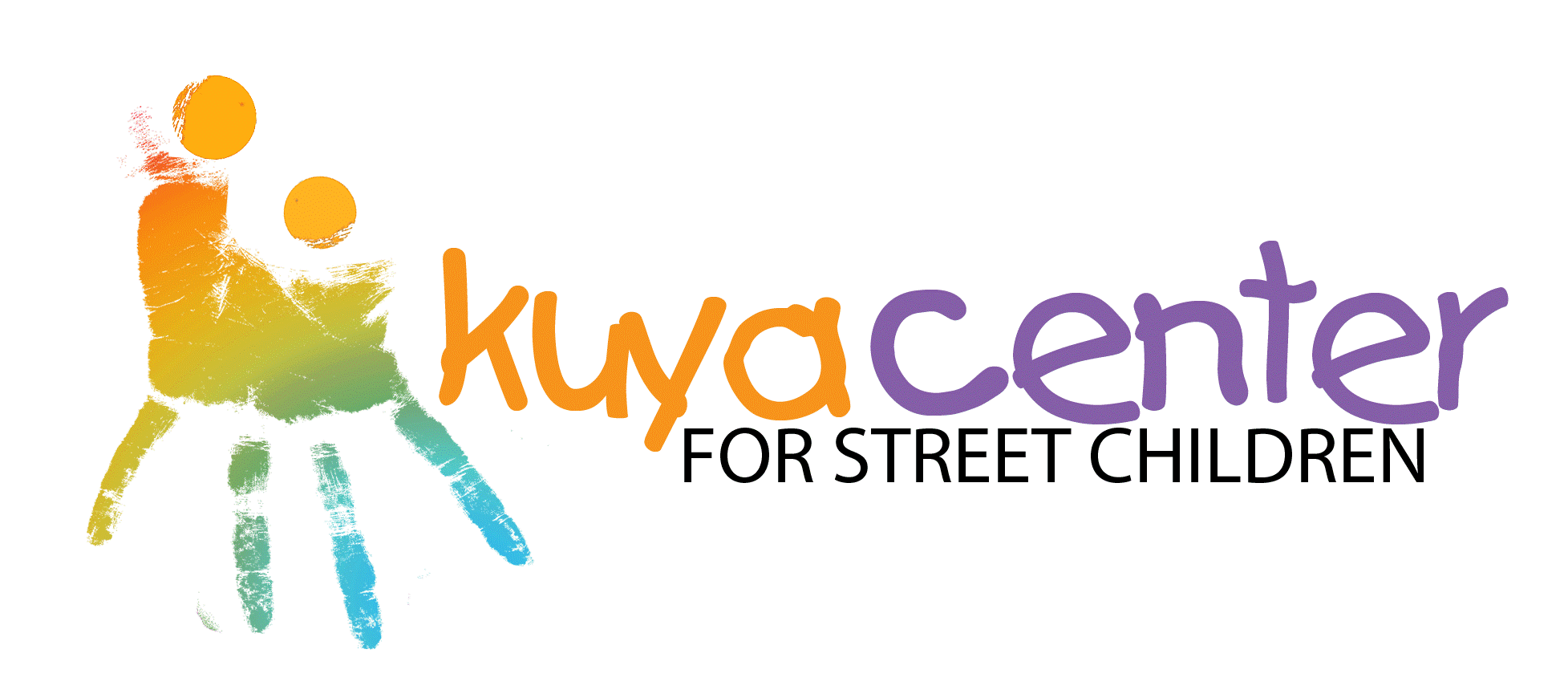January-February 2018
From the Editor
How do we live for Christ?
By Arlenne Villahermosa
At this present age and time, with the advancement in technology and social media, we ask ourselves, “How do we live for Christ?”
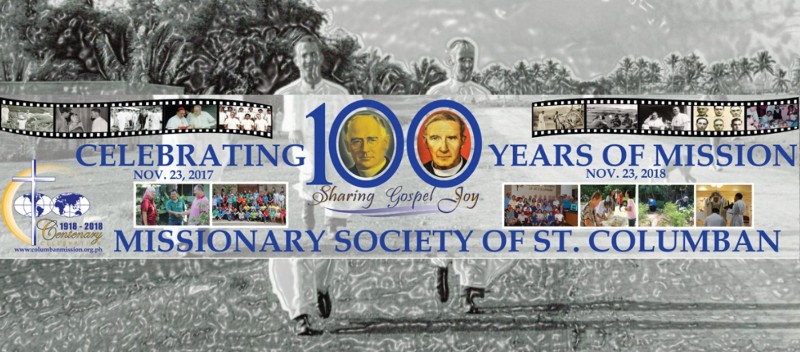
When the founders of the Missionary Society of St. Columban said YES to the call, they did not know where it would lead them yet, with faith, trust and love in their hearts, they sailed on, going beyond their fears and limits, responding to the needs of the people, and constantly being open to be lead to something new, some place new. They lived for Christ. So did the Columban Missionaries who have gone before us and many others who simply lived the Word in the silence of their hearts . . .

100 Years of Columban Mission Through Art:
Through the Eyes of a Filipino Columban
By Fr. Jason Antiquera
The author is a Columban priest from Binalbagan, Negros Occidental. He has spent some time in Korea and Peru as a seminarian. He was ordained on January 7, 2015 and on the same year left for Korea, and has worked there since then.

The Missionary Society of St. Columban was founded by two diocesan Irish priests, Fr. Edward Galvin and Fr. John Blowick, on June 29, 1918. The celebration of the 100th anniversary of the Society’s foundation began on November 23, 2017 and will end on November 23, 2018. Columbans all over the world have been exchanging ideas to create programs and activities for a meaningful centennial celebration. On a personal level, I was glad to be asked to create an art that could capture this hundred-year history of Columban mission. What a task! But it has to be done . . .

Will you shelter me . . . in your heart?
By Mary Joy Rile
Columban lay missionaries of the RP 18 group, Gertrudes “Ger” Samson, Jonah Jane “Jayjay” Enterina-Beddall and Rosalia “Rose” Basada, renewed their commitment with the CLM for another term. They had been assigned to the Region of Britain since 2010 working with asylum seekers and refugees.
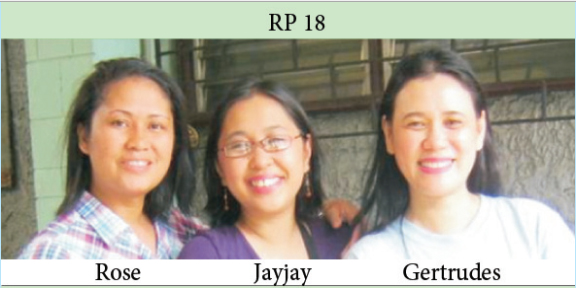
I witnessed the renewal of commitment of Ger and Jayjay on June 28, 2017 at the Columban Lay Mission House in Cubao. At Mass, Jayjay expressed gratitude on behalf of RP18 for the support and prayers offered by family and friends, but even more, gratitude to God for the gift of mission and the richness of their experience. Ger on the other hand expressed the challenges they had to face in mission. A power point presentation of their mission experience was so moving it silenced all of us. Ger’s emotional sharing brought many of us to tears as we couldn’t help but feel and share in their sadness and pain . . .

What the Children at the Kuya Center Taught Me
By Kusitino Saro
Kusitino is a Columban seminarian from Suva, Fiji who joined the Columban formation program here in the Philippines in 2016. He is studying Philosophy at the University of Santo Tomas and conducts pastoral ministry at the Kuya Center in Cubao, Quezon City.
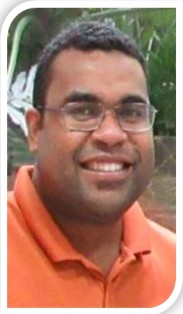 Over the years, the Columban mission has influenced and inspired many people across the world, especially in regions that they are called to serve in. Like many others that have gone before me, I was also fortunate enough to have crossed paths with some of them. The first impression I received during my first encounter with them stayed with me until I decided to join. This was one of the important decisions I made that somehow would determine the later course of my life’s journey . . .
Over the years, the Columban mission has influenced and inspired many people across the world, especially in regions that they are called to serve in. Like many others that have gone before me, I was also fortunate enough to have crossed paths with some of them. The first impression I received during my first encounter with them stayed with me until I decided to join. This was one of the important decisions I made that somehow would determine the later course of my life’s journey . . .

How Do Candles Light a Life
By Mary Joy Rile
The author is assistant editor of MISYONonline.com and Columban Mission. She visited Light The Life Candles Community in Novaliches and in another occasion was able to interview two mothers. The sharing by Mrs. Joy Price Sullano was published in September-October 2017 issue of MISYONonline.com. Here is the second one, a sharing by Mrs. Emerlyn Pollescas.
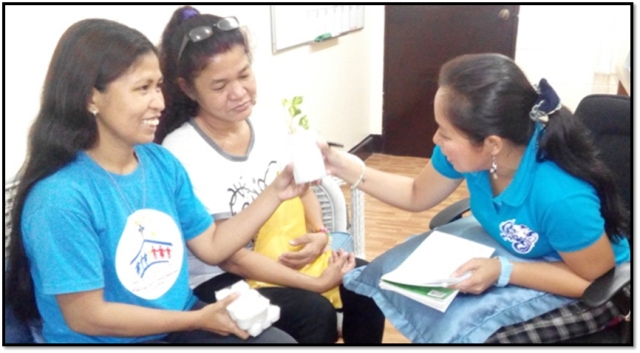
Emerlyn Pollescas (left) and Joy Price Sullano (center) on their visit at Misyon office in Singalong
In the picture, Emerlyn is showing the author the candles that she made.
How do candles light a life? To name some: it may brighten a dark room or maybe the darkness within; it may lit up somebody’s hope and bring ones prayer intentions to God. But for a woman I met, candles gave her a chance for a living, a new hope, and reconnected her with her children . . .

Knowing God in Life’s Circumstances
By Hazel Angwani
Hazel is from Bontoc, Mountain Province and is currently undergoing the Columban lay missionary Orientation program with Ma. Fe Corazon Arienza.
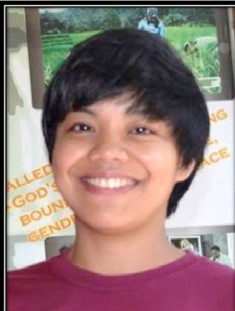 I have always believed that life is full of choices, and that the circumstances that surround us in life are not for us to suffer in agony but to learn about ourselves and God. I had a very beautiful and enjoyable childhood, and I can still vividly remember some of it. But there comes a point in life when in a blink of an eye, we are forced to grow up, consciously or unconsciously, not entirely forgetting how to be childlike but we begin again to learn how to adapt to life’s circumstances . . .
I have always believed that life is full of choices, and that the circumstances that surround us in life are not for us to suffer in agony but to learn about ourselves and God. I had a very beautiful and enjoyable childhood, and I can still vividly remember some of it. But there comes a point in life when in a blink of an eye, we are forced to grow up, consciously or unconsciously, not entirely forgetting how to be childlike but we begin again to learn how to adapt to life’s circumstances . . .

January – February 2018
You have turned my mourning into dancing;
you have taken off my sackcloth
and clothed me with joy,
so that my soul may praise you and not be silent.
O Lord my God, I will give thanks to you forever.
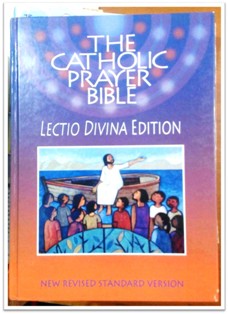
~ Psalm 30:11-12

100 Years of Columban Mission Through Art
Through the Eyes of a Filipino Columban
By Fr. Jason Antiquera
The author is a Columban priest from Binalbagan, Negros Occidental. He has spent some time in Korea and Peru as a seminarian. He was ordained on January 7, 2015 and on the same year left for Korea, and has worked there since then.

The Missionary Society of St. Columban was founded by two diocesan Irish priests, Fr. Edward Galvin and Fr. John Blowick, on June 29, 1918. The celebration of the 100th anniversary of the Society’s foundation began on November 23, 2017 and will end on November 23, 2018. Columbans all over the world have been exchanging ideas to create programs and activities for a meaningful centennial celebration. On a personal level, I was glad to be asked to create an art that could capture this hundred-year history of Columban mission. What a task! But it has to be done.
The art impression is based on the centennial prayer and the journey of Columban Missionaries way back from the time of our founders up to the present. While reflecting, I let its message sink into my consciousness, allowing images to form and arrange themselves naturally in my mind. After such preparation, I sat down and painted these images. And what came out was a symbolic art filled with familiar and not-so familiar meanings. This is the artwork and its meaning, a product of prayerful reflection.
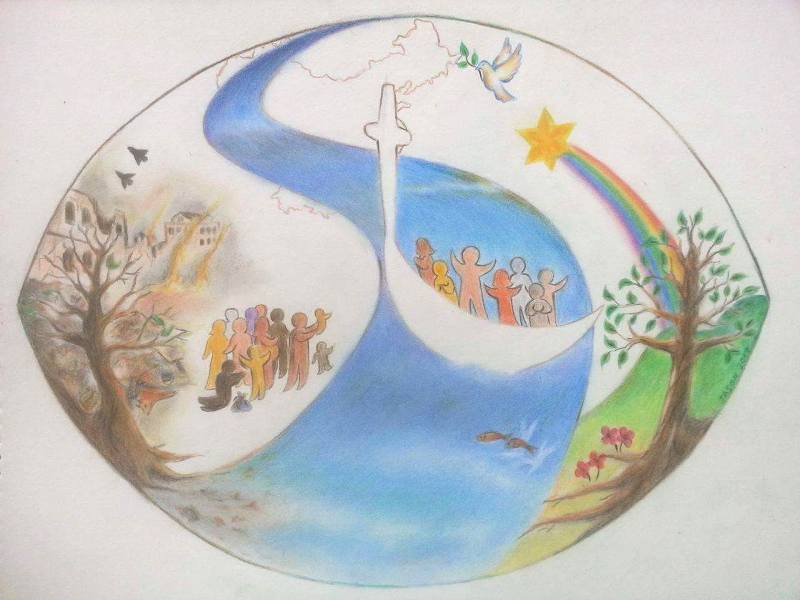
Mandorla. As one can immediately notice, the artwork takes in the form of an almond shape called Mandorla. The first inspiration of this shape is the official logo of the Society, taking only the middle portion where two worlds meet.
Boat. This widely-used image has been a traditional symbol often used by the Columbans, getting its inspiration from St. Columban sailing on a boat together with other monks. By using this image, I want to affirm the continuity of this tradition way back from the time of our founders. However, there are new and current developments in and about mission: the images of people found in the boat are of different colors and includes female images; this recognizes the present reality of multi-culturality and multi-ethnicity in the membership of the society, and the participation of lay and women in the missionary work of the church.
River. It represents journey and movement in time and space through which mission flows. The various spectrums of colours of the river is intentional; time and space are always not the same; there are changes and mission goes with them. Likewise, water is very important in the spirituality of mission; mission just like water is fluid and not fixed; water takes the form of anything concrete where it passes and, I believe, that's what we Columbans have embraced – fluidity. Historically, we constantly change our approach to mission depending on the situation of the world and the Church.
An outline of China's map. I put an image of China's map because the missionary journey of the Society started in China. I placed it in the far end of the river's horizon to signify its existence since the beginning of Society's mission. The image only takes the form of an outline recognizing its subdued but significant presence in the missionary life of the Society.
The cross, the crescent moon and the star. If you ask where the crescent moon is, the boat takes that form, while the star takes the specific form of David's star. They all symbolize the present call of inter-religious dialogue in mission where we Columbans are actively involved.
The group of people standing beside the river, the dying tree, garbage and war on the left side of the mandorla. The people represent the poor and the migrants, a crucial global issue and an important concern of the Church’s mission at the moment. Poverty and migration are direct results of war, and indirectly by the destruction of environment and climate change. These are all issues of justice, peace and integrity of creation, which many of the Columbans everywhere in the world are actively participating.
The green pasture, a tree filled with leaves and flowers on the right side of the mandorla. They all represent life, beauty and the kind of world where we hope to live; it's like the reign of God on earth – already present but not fully. The rainbow is a significant symbol in the book of Genesis representing God's first sign of covenant to the entire creation and God's faithfulness to His people. In our case, this covenant is made present and visible through mission. I also put the traditional symbol of peace and hope – the dove with an olive branch seen over the boat to represent that missionaries strive to work for peace and give hope to the world. The dove is also a shadow representation of St. Columban (whose name means “White Dove”).
The cross at the center. God through Jesus Christ is the heart of mission work. God is present in the journey of Columban missionaries wherever they go to proclaim the Good News to the world and become witnesses of the joy of the Gospel.
Over-all, I did not fill the entire space with colors and images but rather left some empty white untouched spaces so that images and color stand out and give room for breathing.
It was a challenge to express and put together through art the hundred years of mission history of the Society. However, it was also my joy to be able to express the Columban history, spirituality and journey through the language of symbols, images and colors when often they are only expressed in words.
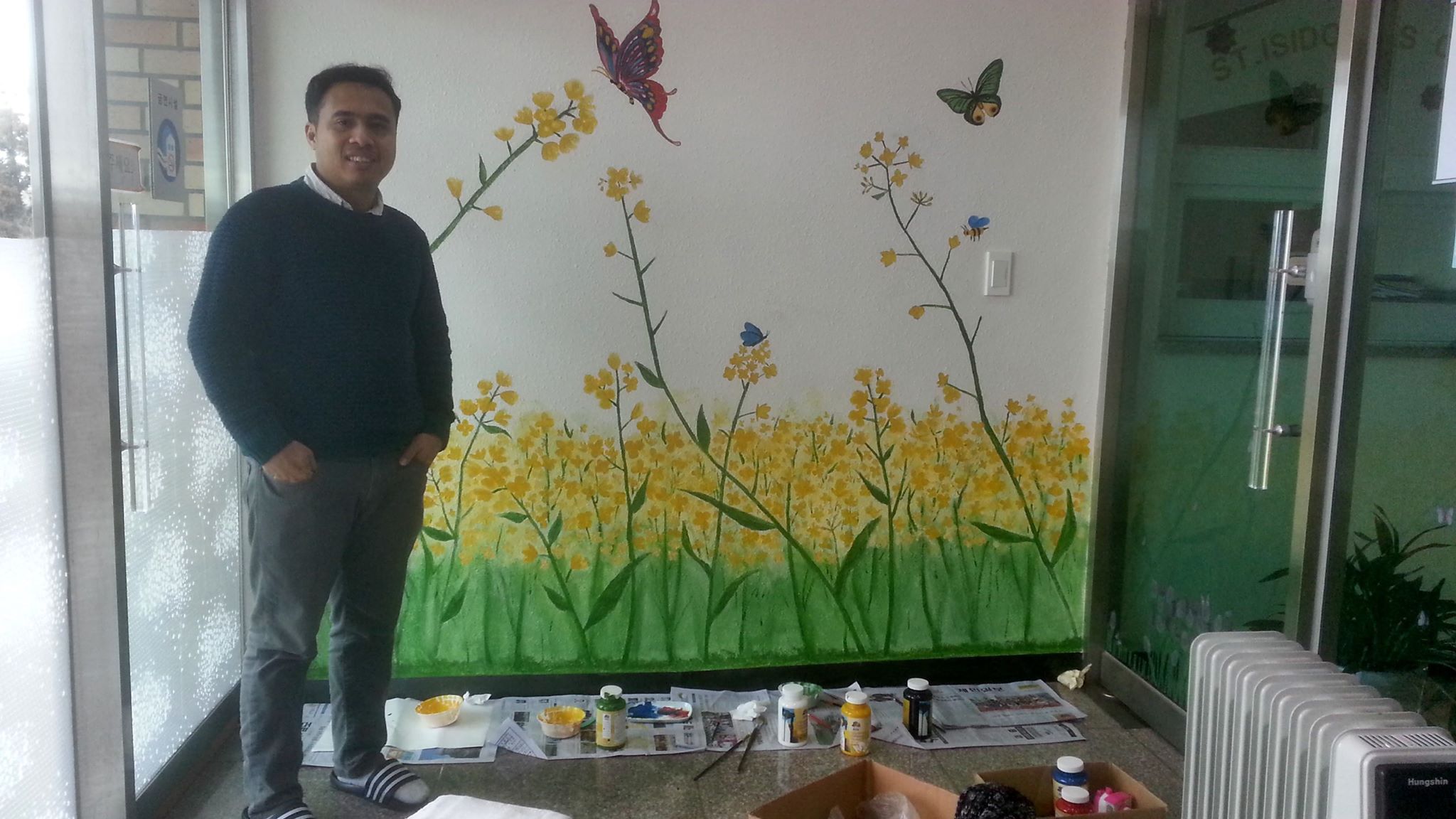
Mural by Fr. Jason Antiquera, Korea, 2017
The mural is located at the entrance of the hospice inside St. Isidore Farm, which was established by Columban Fr. Patrick J. McGlinchey in Jeju Island.
From the Editor
How do we live for Christ?
By Arlenne Villahermosa
At this present age and time, with the advancement in technology and social media, we ask ourselves, “How do we live for Christ?”

When the founders of the Missionary Society of St. Columban said YES to the call, they did not know where it would lead them yet, with faith, trust and love in their hearts, they sailed on, going beyond their fears and limits, responding to the needs of the people, and constantly being open to be lead to something new, some place new. They lived for Christ. So did the Columban Missionaries who have gone before us and many others who simply lived the Word in the silence of their hearts.
Arlenne at a feeding program for the Elderly, Korea
When I was in Korea for my first mission assignment, I met an elderly woman who later became a close friend of mine. She was living alone and had to depend on the generosity of others to survive. She always greeted me with a smile – one that would make a stranger feel at home and welcomed. One day when I was still new to the area, while climbing up the hill from a long, tiring day, she saw me from afar and with arms wide open met me half-way up the hill and gave me a big, warm embrace that lasted forever, without any word spoken. It felt so good. It uplifted my tired self. She welcomed a stranger (me), with open arms. I felt like I was being hugged by Jesus with her small loving arms. On another occasion, one winter morning when the temperature was below zero, I met the same person on the road. She was carrying some stuff. When she saw me, she called me and gave me two (2) beautiful winter clothes she had received from the bazaar. I was hesitant to take it and told her that she needed them more. She insisted that I take them saying, “I am from the place. You are new and you need it more.” From the little that she had, she freely and joyfully shared her blessings.
Arlenne with Kachin women preparing for a meal for St. Columban's Day celebration, Myanmar
In Myanmar, there is a village where people set aside a handful of rice grains each time before they cook. They save this in a container. Once a month, usually on a Sunday, the parishioners would gather in the Parish Hall bringing with them the grains of rice they had saved. These collections would be gathered together as one and re-packed to be given to those who were most in need. Whatever was left would be given to the Catechists who also depended largely on the generosity of the parishioners and the allowance they received from the parish. The parishioners knew how to share with others from whatever they had, building a caring community.
Columban Fathers Patrick Madden and Patrick Conneally with some teachers in Banmaw, Myanmar
In my encounters with people who knew the Columbans, the first thing they would share was how good the Columbans were as missionaries. The Columbans nurtured their faith, educated them, ate with them, visited their homes, played and prayed with them, stayed with them in their difficulties and accompanied them in their journey. The Columbans walked with them.
These were instances wherein I witnessed and experienced how people lived the Word they received - welcoming a stranger, sharing from their hearts with whatever they have, building a caring community and walking with them.
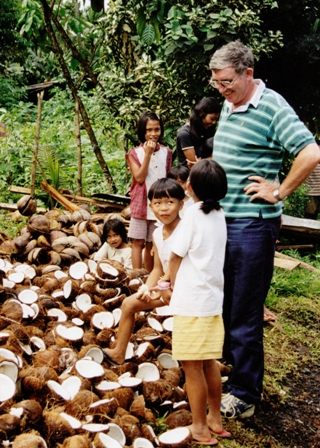
Columban Fr. Sean Martin at a coconut harvest, Philippines
We are called to respond to the challenges and needs of the present time, from what we have and where we are, inviting us to see the face of God in the people we meet each day, the poor, the victims of violence and those in dire situations. We are also invited to see the face of God in the opportunities that come our way, the gift of the present moment, the beauty around us…
In December 2017, Philippines had been ravaged by typhoons. Many families lost their loved ones. Their properties were destroyed, and family members were traumatized by the experience. The people and the places affected need our immediate caring response. We are called each day to make a difference.
We don’t have to wait for new year to make resolutions and start doing something we care about. Each day is a new day, a new opportunity for us to truly accept and appreciate who we are, what we have now and the world that we are living in. When we take this into heart, we will be able to respond in freedom, open up ourselves to possibilities and allow the Spirit to lead us to where she may want to take us. Then we will be able to follow the footsteps of those who have gone before us, who lived their lives for Christ.
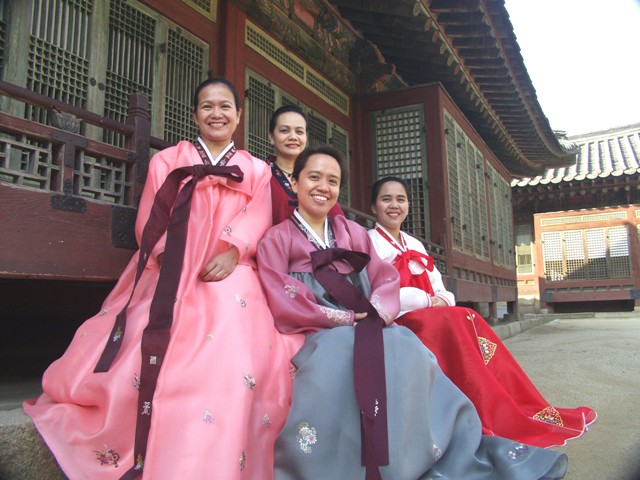
Members of RP11, the 11th group of Filipino Columban lay missionaries, assigned to Korea, 2002-2005
L-R: (front) Cristina Simpron, Arlenne Villahermosa; (back) Necita Fetalvero and Cristina Camacho
How Do Candles Light a Life
By Mary Joy Rile
FteuThe author is assistant editor of MISYONonline.com and Columban Mission. She visited Light The Life Candles Community in Novaliches and in another occasion was able to interview two mothers. The sharing by Mrs. Joy Price Sullano was published in September-October 2017 issue of MISYONonline.com. Here is the second one, a sharing by Mrs. Emerlyn Pollescas.

Emerlyn Pollescas (left) and Joy Price Sullano (center) on their visit at Misyon office in Singalong
In the picture, Emerlyn is showing the author the candles that she made.
How do candles light a life? To name some: it may brighten a dark room or maybe the darkness within; it may lit up somebody’s hope and bring ones prayer intentions to God. But for a woman I met, candles gave her a chance for a living, a new hope, and reconnected her with her children.
Emerlyn Pollescas is one of the mother beneficiaries of (LTL) Light The Life Candles in the Diocesan Shrine of Our Lady of Mercy. She joined LTL on May 5, 2015 when Anna Noh Hyein, a Columban lay missionary, brought an application form inviting her to join the team. Along with other mothers, Emerlyn didn’t have any idea on candle-making. The only requirement was for them to attend the intensive training for two weeks at St. Peter Parish in Commonwealth Ave. Afterwhich, they started making candles at a space offered by the nuns at Holy Angel's Convent. They stayed there for five months until they acquired a rented space in Ramirez Subdivision, Novaliches in October 2015.
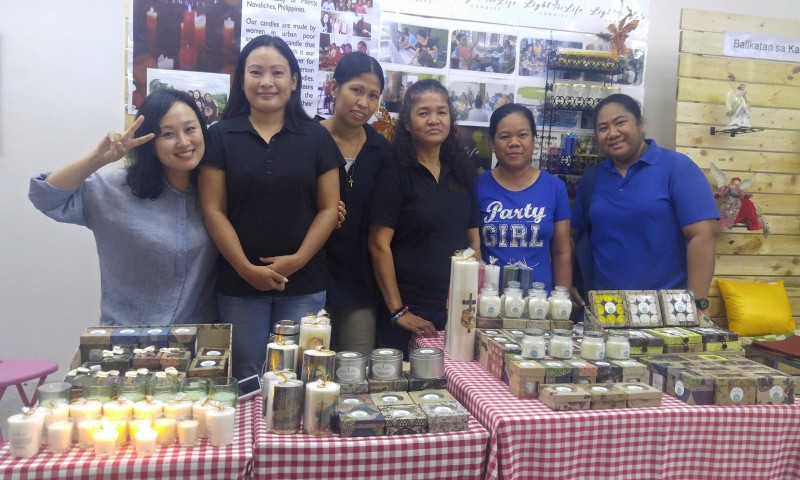
Light the Life Candles in Ali Mall, Quezon City during the Likhang Pilipina: Women's Marketplace Exhibit, 2016
L-R: Anna Noh Hyein (Columban lay missionary from Korea); Irene Gorembalem, Emerlyn Simborio and Joy Price Sullano (LTL mothers); Rustica Eufre (Columban worker); and Nanise Mo’unga (Columban lay missionary from Tonga)
“Mahirap po sa simula. Pero kung isasapuso mo, kung nandun yung sipag at tiyaga, yan po ang puhunan ng bawat nag aapply doon.” Emerlyn is grateful for the opportunity to earn an income that enables her to extend help to her family. She feels blessed that her son, Jason, is one of the 12 scholars of LTL at present. She is most grateful to God for sending her and other mothers the help that they need in the person of Anna who brought the candle-making project to their Basic Ecclesial Community.
The LTL is also faced with challenges in working together. Misunderstandings come once in a while due to individual differences but they are able to solve the problem with proper communication. They learn to accept each other. Emerlyn emphasized the need for unity, “Ang mga katrabaho mo, mas higit pa sa pamilya mo kasi buong araw mong nakakasama kaysa sa pamilya mo na gabi lang kayo nagkikita.”
Another challenge confronted Emerlyn when she didn’t have someone to look after her baby. She thought of giving up the work to take care of her youngest child. But God sent her her neighbor and that solved the problem.
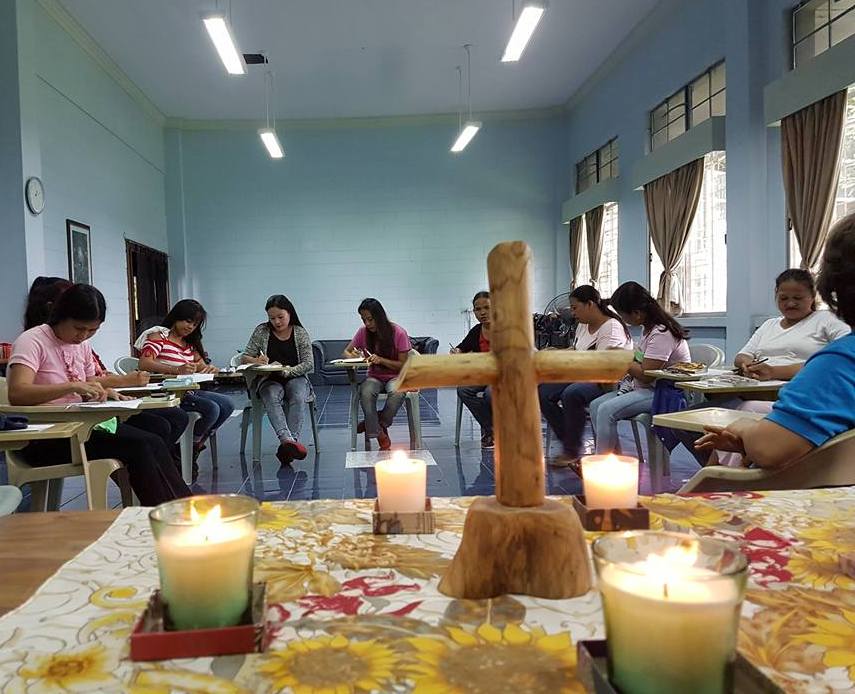
Light the Life Candles Recollection, 2017
Emerlyn believes that with God, every problem will always have a solution. Her very prayer was answered recently when she was able to communicate with her three other children whom she left in Ozamiz. At the beginning, they kept in touch with each other. Unfortunately, they got disconnected when their cousin who had Emerlyn’s number left to work abroad. Every day of her life for five years, she suffered with that longing to be in touch with her children again. Wherever her work took her, she always prayed that one day she would again be able to communicate with her children in Ozamiz. Through facebook they were able to reconnect and started exchanging messages, and eventually talked with them over the phone. They were overjoyed. It is a dream come true. This is the best gift that she received while working with LTL. She remains grateful to God who truly listens and answers prayers. The answer may not come instantly but as long as you keep the faith, it will come in due time. Now she is more motivated to work better.
Emerlyn, a mother, prays to God entrusting her children, “Lord, kahit wala ako sa tabi nila, gabayan nyo po sila palagi. Yakapin mo sila na tulad ng pagyakap ko sa kanila gabi-gabi, at bawat oras ligtas lang po sila.”
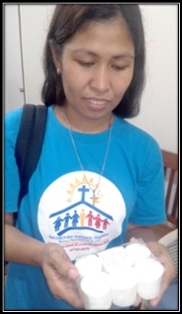
Emerlyn with white candles that she made
Emerlyn used to work in a fastfood chain. She loves cooking. She shares that in cooking, you need to give love. It is the same with candle-making, you need to love your work in order to produce beautiful and well-crafted products. Making white candles makes her think of peace. It also gives her the fondness imagining that other people lit the candles she made with love.
For every candle that the mothers of Light the Life Candles are making, it is with great hope that in its simplicity, it will also bring others the blessings they need, that God may grant the desires of their hearts as they lit each candle with loving intentions. May it also spread the kind of light that will illumine somebody’s life.
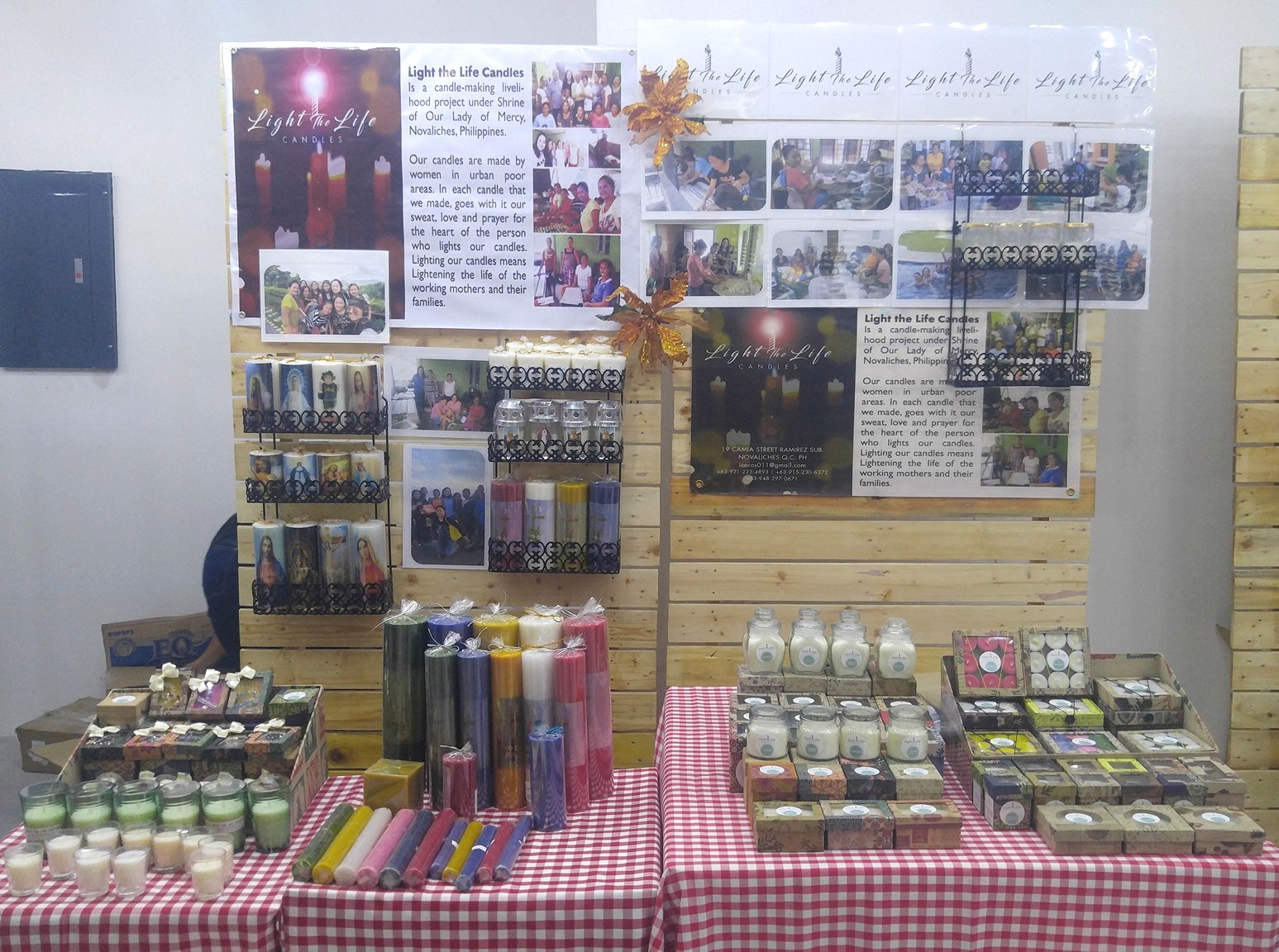
Light the Life Candles
Our Hideaway
Knowing God in Life’s Circumstances
By Hazel Angwani
Hazel is from Bontoc, Mountain Province and is currently undergoing the Columban lay missionary Orientation program with Ma. Fe Corazon Arienza.
 I have always believed that life is full of choices, and that the circumstances that surround us in life are not for us to suffer in agony but to learn about ourselves and God. I had a very beautiful and enjoyable childhood, and I can still vividly remember some of it. But there comes a point in life when in a blink of an eye, we are forced to grow up, consciously or unconsciously, not entirely forgetting how to be childlike but we begin again to learn how to adapt to life’s circumstances.
I have always believed that life is full of choices, and that the circumstances that surround us in life are not for us to suffer in agony but to learn about ourselves and God. I had a very beautiful and enjoyable childhood, and I can still vividly remember some of it. But there comes a point in life when in a blink of an eye, we are forced to grow up, consciously or unconsciously, not entirely forgetting how to be childlike but we begin again to learn how to adapt to life’s circumstances.
My mother used to work in another municipality, so my father had to be with her to take care of my two younger siblings. My older siblings were attending school in yet another municipality, so I was left on my own in our village. As a result, we had to live apart from each other to be able to keep the finances coming and our future, through education, going. Living alone was very lonely. But one way or the other, I was able to learn many things on my own and from others as well.
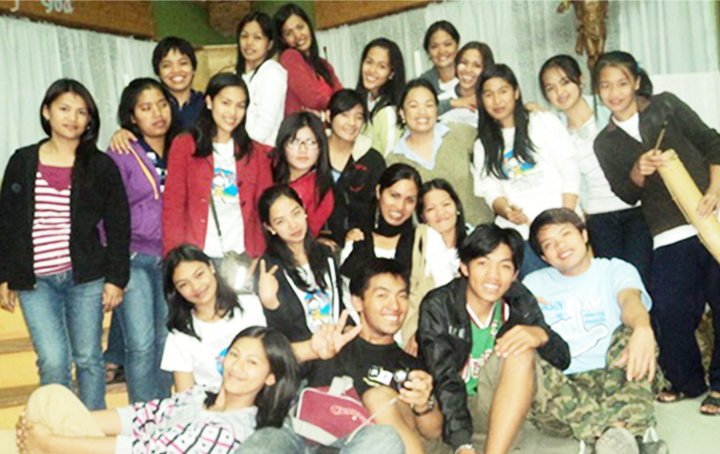
Hazel, standing at the back third from left, with some members of the Talubin Catholic Youth Organization after the Christmas recollection mass, 2016
One of the greatest helps that kept me going during those times I was apart from my family was my involvement in the Church. I always looked forward to the catechism class every Saturday. After the classes we were encouraged by the catechists and seminarians, who were working on the improvement of our chapel at that time, to join the practice of songs for the Mass the next day. It was then that I grew fond of the guitar which later on I learned to play on my own. I enjoyed every moment in singing during the Mass. I also loved to listen to the homilies as the priest made sure that the community understood what the gospel was all about and its connection to everyday life. I learned how to pray fervently and with passion. Slowly, I found joy in being with and working with others for the sake of building the kingdom of God on earth. After elementary school, until the time I decided to join the Orientation Program of the Columban Lay Missionaries, I was an active youth member in our Basic Ecclesial Community (BEC). Together with other young people, we went to other BECs to sing at masses and weddings.
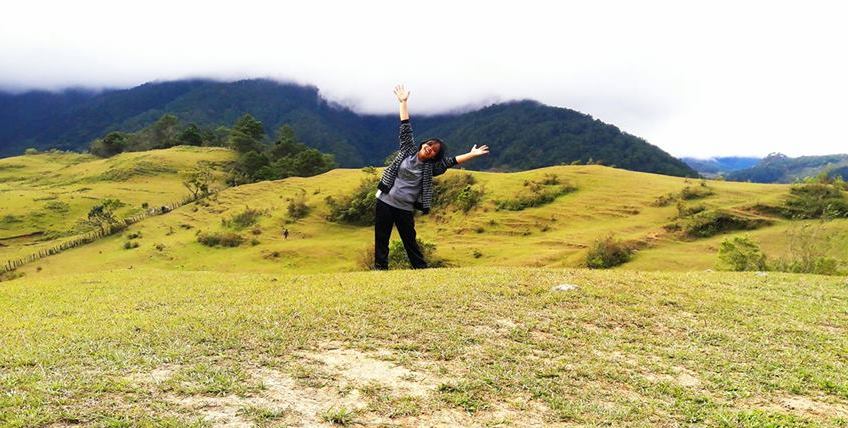
Hazel in her hometown Bontoc
Through my family, I came to know of “Someone Above All Things” and through the circumstances He gave me, my faith in Him grew clearer and stronger. Truly, I know that if I fall down, I also have a thousand reasons more to get up. I know that all things are possible because of our faith in the “One Who Made All and Sees All”, and that is God.
PEACE BY PEACE
January – February 2018
You have turned my mourning into dancing;
you have taken off my sackcloth
and clothed me with joy,
so that my soul may praise you and not be silent.
O Lord my God, I will give thanks to you forever.

~ Psalm 30:11-12

Things in the universe put up a resistance because each being and each community of beings has its own quantum of value. Things come to be what they are out of their cosmological power of creativity. As manifestations of ultimate meaning and significance, they resist all efforts to reduce their presence in the world. Even at the level of elementary particles we find this irreducible reality of the individual. The universe, in protecting the viability of an elementary particle, works to assure the particle of its place, of its role in the unfolding story.
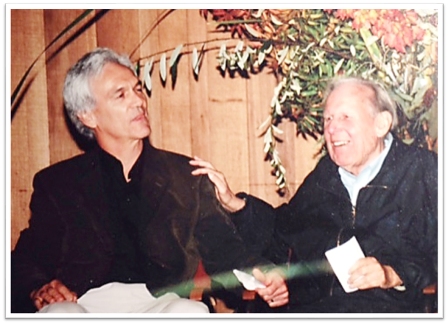
Brian Swimme and Thomas Berry
~ Brian Swimme and Thomas Berry, The Universe Story: From the Primordial Flaring Forth to the Ecozoic Era – A Celebration of the Unfolding of the Cosmos

Be seekers of truth and doers of justice.
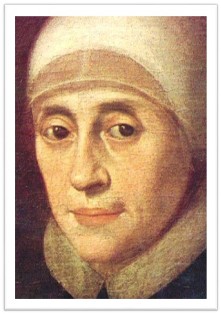
~ Mary Ward, Foundress of the Institute of the Blessed Virgin Mary (1586–1645)

Love is the measure by which we shall be judged.
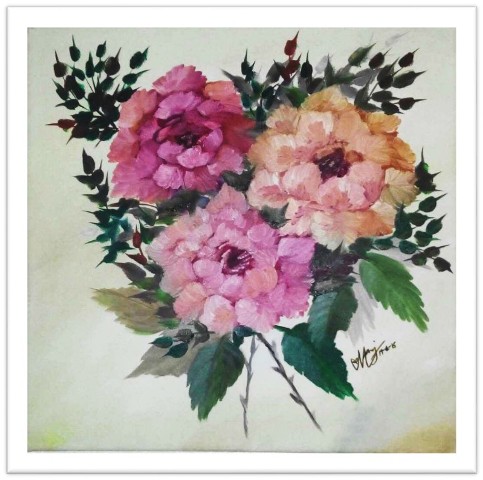
Flowers painted by Marjorie Engcoy, 2015
~ St. John of the Cross, Mystic and Doctor of the Church (1542–1591)

Love Begins by Praying Together
Where does that love begin?
In our families.
And how does it begin?
By praying together.
The family that prays together, stays together.
And if you stay together, you will love one another as Jesus loves each person
in your family.
Make sure that in the beautiful place where you live no child, no man, no woman feels unwanted or unloved. If you find somebody who feels that way, open your doors, open your hearts to them.
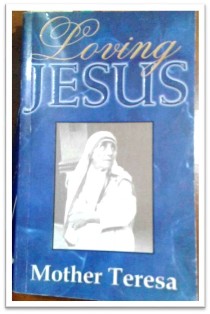
~ Mother Teresa, Loving Jesus
What the Children at the Kuya Center Taught Me
By Kusitino Saro
Kusitino is a Columban seminarian from Suva, Fiji who joined the Columban formation program here in the Philippines in 2016. He is studying Philosophy at the University of Santo Tomas and conducts pastoral ministry at the Kuya Center in Cubao, Quezon City.
 Over the years, the Columban mission has influenced and inspired many people across the world, especially in regions that they are called to serve in. Like many others that have gone before me, I was also fortunate enough to have crossed paths with some of them. The first impression I received during my first encounter with them stayed with me until I decided to join. This was one of the important decisions I made that somehow would determine the later course of my life’s journey.
Over the years, the Columban mission has influenced and inspired many people across the world, especially in regions that they are called to serve in. Like many others that have gone before me, I was also fortunate enough to have crossed paths with some of them. The first impression I received during my first encounter with them stayed with me until I decided to join. This was one of the important decisions I made that somehow would determine the later course of my life’s journey.
Ever since my introduction to formation life, I was told that whatever lessons I would learn from our formation journey should be directed towards my future ministry. However, like other life journeys it sure has a lot of challenges, but through these challenges many important lessons have been learned.
Pastoral formation was one of the many areas that I was introduced to. This area of formation was just as important as the rest, but for me this was one of the areas that I had hoped to improve on, especially in relation to those whom I encountered in my pastoral ministry. The first few weeks were difficult for me. Like a child who is learning how to walk, I would stumble and fall, but each time it happened, like the child, I would slowly get back up on my feet.
Children indeed, were those whom I accompanied every Saturday. Each of the children came from a different family background, each from different part of Manila. But the common factor among them was that they all came from families that were either broken or struck down by the heavy hand of poverty.
However, these children were fortunate enough to have been invited in to the Kuya Center. The Kuya Center is a shelter that was founded by Religious Brothers and other religious missionary societies, and after a few years, the Sacred Heart Brothers took over from where the founders left off. It is funded by numerous donors and by the government to shelter children from ages four to sixteen, allowing them to be formally introduced to education and other lessons in life that would guide and help them build a better life. Like all children they are innocent and cannot complain much of the difficult upbringing that they are experiencing. It is the task of the center to help them so that they can be spared from the heavy hand of poverty and later become beacons of hope to their loved ones.
Despite the hardships that they are going through and considering that they are only children, they have taught me important lessons that will help me in my formation journey. They have taught me the importance of patience, understanding, team work, honesty and commitment. The determination and the energy they possess inspired me; the conviction they have with every spoken word and the action that followed was heart-warming; and the smile that they gave when they were able to achieve a task brightened each day of every encounter.
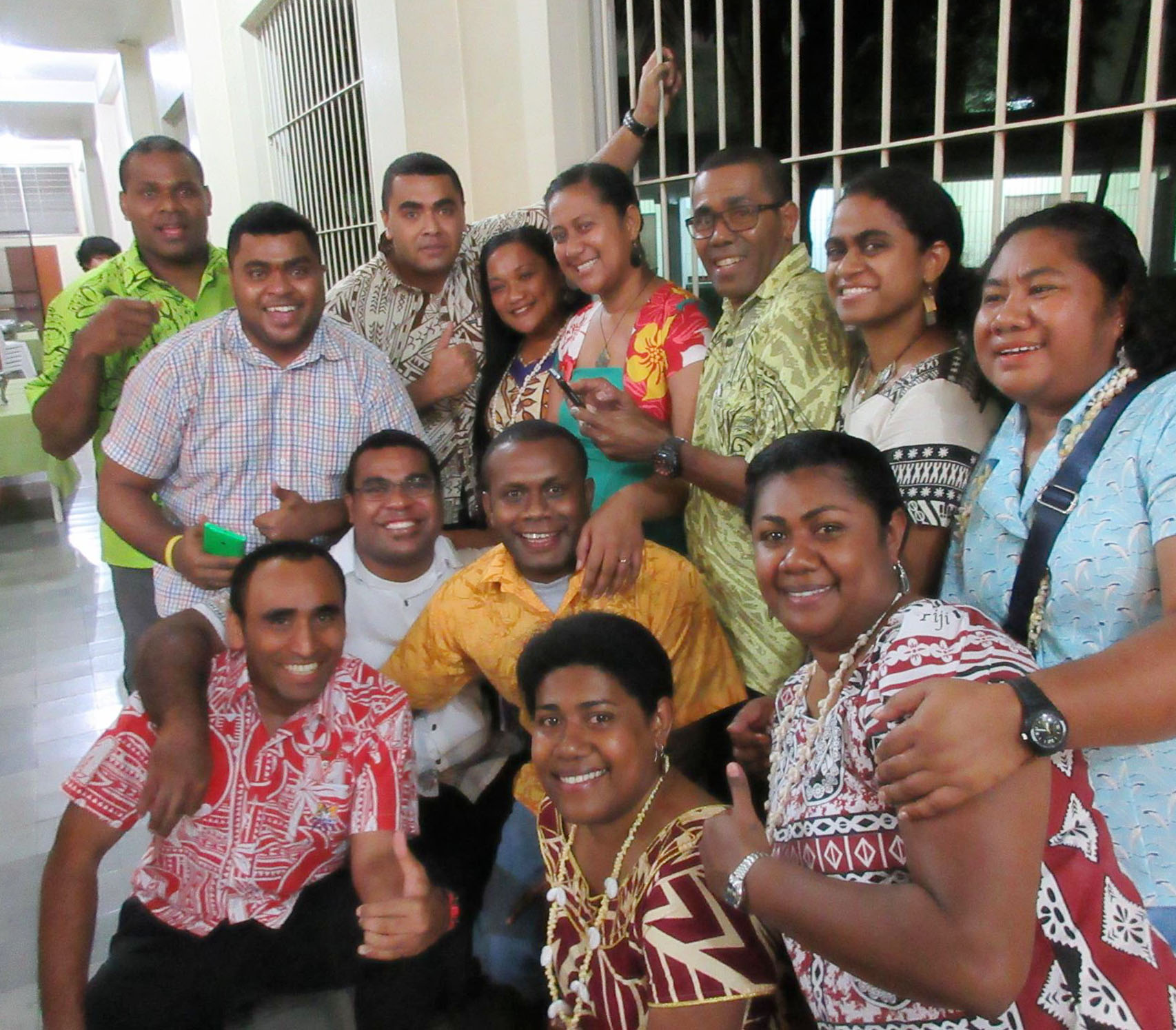
Kusitino with the Fiji/Tonga Group of Columbans in the Philippines
All the lessons that I have learned during this brief encounter at the Kuya Center are not only meant for pastoral purposes but also to fuel my formation journey. I pray that with God’s guidance I will gain the ability not to take things assigned to me as tasks that need to be completed, but to take them as experiences that need to be lived.
Will you shelter me . . . in your heart?
By Mary Joy Rile
Columban lay missionaries of the RP 18 group, Gertrudes “Ger” Samson, Jonah Jane “Jayjay” Enterina-Beddall and Rosalia “Rose” Basada, renewed their commitment with the CLM for another term. They had been assigned to the Region of Britain since 2010 working with asylum seekers and refugees.

I witnessed the renewal of commitment of Ger and Jayjay on June 28, 2017 at the Columban Lay Mission House in Cubao. At Mass, Jayjay expressed gratitude on behalf of RP18 for the support and prayers offered by family and friends, but even more, gratitude to God for the gift of mission and the richness of their experience. Ger on the other hand expressed the challenges they had to face in mission. A power point presentation of their mission experience was so moving it silenced all of us. Ger’s emotional sharing brought many of us to tears as we couldn’t help but feel and share in their sadness and pain.
The refugees and asylum seekers in Britain are of different profiles, coming from different countries for different reasons: war, persecution due to religion, internal conflict in their own country, conflict with authorities, escaping the tradition of their culture like forced marriages, and domestic violence. Ger and Jayjay were there to help them as volunteers from various charitable organizations. Mainly, they helped by conducting seminars (e.g. about new immigration rules) and learning activities for the refugees and asylum seekers (e.g. sewing and crafts-making), listening to their stories of struggles, and offering assistance to the refugees in various capacities as they processed their legal requirements for admission to Britain.
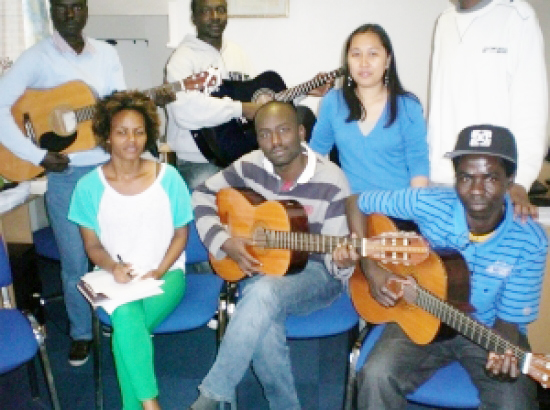
Jayjay teaching asylum seekers and refugees how to play the guitar, 2012
The refugees and asylum seekers would come and go. At times the volunteers got to encounter them, unsure if they would see them the following day. But the goal of the volunteers was to journey with each refugee and each asylum seeker. From a simple encounter through the engaging activities, the volunteers got to establish friendship and build trust. That was when the refugees began to open up and share their struggles with those who wished to help.
The volunteers and the refugees and asylum seekers came from different faith traditions and religions, but they shared prayers for one another. It is somehow a humbling experience to hear someone of another religion to ask you to “Please pray for my case, please pray for me”. And even for a mother to request you to join her and her child in praying. The ministry of listening and the sharing of different faiths enriched the hearts of all.
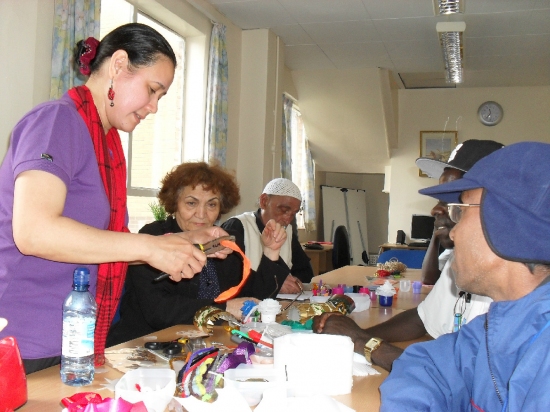
Ger in a "Recycled Craft" session with asylum seekers and refugees, 2012
Shelter is one of the human person’s most basic needs for survival. And yet, for these people who had lost their homes, they experienced not only the devastating loss, but also discrimination and frustration as well. Their dreams for a more peaceful life were shattered.
The refugees whom Ger and Jayjay encountered in Britain had hoped to find a new home. But, before they could get a new home, they had to undergo months of evaluation. The hearing of their cases runs from 6 months up to 12 years, depending on their situation. They may have found a temporary refuge as they register themselves as asylum seekers but they are in limbo as they await the final judgment of their cases. It is good for them if they receive news that they have been accepted as citizens of the country. But for others, the news is not good. They are refused a place to stay, detained or deported. These people often choose suicide as an option. It is heartbreaking, indeed.
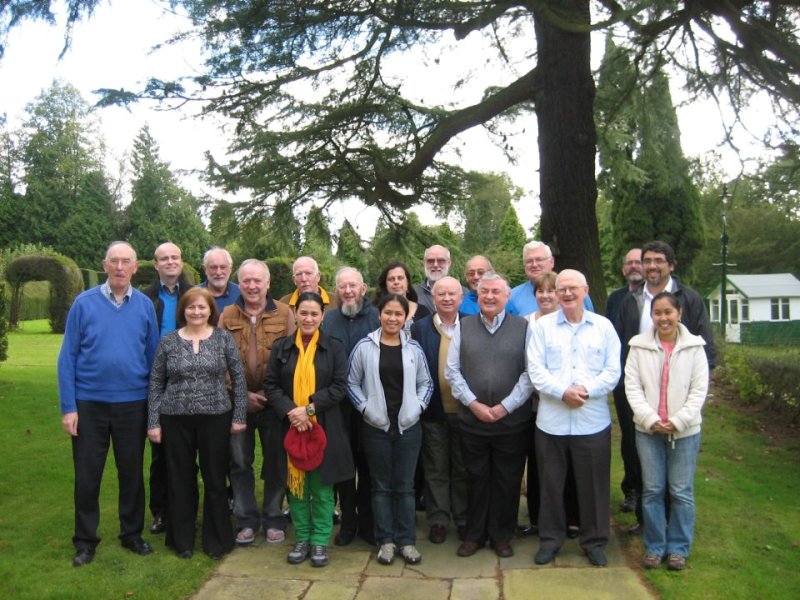
RP18 with Columbans in UK, 2013
But for the refugees and asylum seekers, the most immediate need is shelter. As they are waiting and hoping for acceptance in a host country, there is yet a much greater need and you can almost hear their silent plea, “Will you shelter me… at least… in your heart?” Ger and Jayjay responded to this plea and that response brought them to a more meaningful mission experience. Ger and Jayjay discovered that what they shared with the refugees and asylum seekers allowed them to find a home in the hearts of many.
Being denied a home causes immeasurable pain for those involved. Ger and Jayjay had to deal with this kind of experience with every refugee. However, it never occurred to them that they were to be in the same situation and feel that same kind of pain. When it came time to renew their Visa to stay in Britain and continue their work, they were denied a visa and driven out of the country. The very country that they served for some time had now denied them a home.
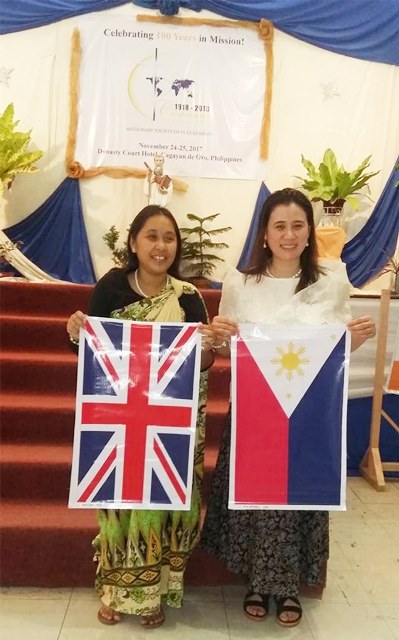
Jayjay and Ger holding the flags of Britain and the Philippines at the Launching of Columban Centenary Celebration in Cagayan de Oro City, November 2017
When the two missionaries arrived back in the Philippines, they received further depressing news – there was a war raging in Marawi, the Maranaos were fleeing the city. Once again, they found themselves without a home because this evacuation affected the families they stayed with during their immersion while preparing for mission. Fr. Paul Glynn shared his sympathy with the two as he also felt for Marawi, which had also been his home for a long time. What kind of hope should Ger and Jayjay hold given the realities of the two countries that they dearly love? As for their desire to go back and serve in Britain, we can only pray that it might be God’s Will. We carry on the hope and prayers for the two countries – Britain and the Philippines – and for the whole world.
Ger tells us more of her experience through the lines of a poem written a few years back:
Gertrudes, where have you been?
Gertrudes, Oh Gertrudes,
Where have you been?
I've been in England,
guess what I have seen?In England, in England?
What have you seen?
Asylum seekers, refugees, migrants
needing help and assistance,
That's what I have seen.Sanctuary and safety
they are hoping within.
Fleeing persecution and violence
from what they have been.Making them feel welcome,
at peace now where they are in.
As I tried to journey with them
so they would be stronger within.Simple, oh simple,
act of faith and love it might have been
My humble contribution,
towards World Peace
we are hoping to be seen.Crossing boundaries of faith, race, culture,
all discrimination that we have seen.
Following my savior and friend Jesus Christ
doing good and loving anyone he had seen.In England, in England,
Yes I have been!
Someday, I hope you would also see
What I have seen.
If not with your own eyes,
I hope at least in your hearts within.


